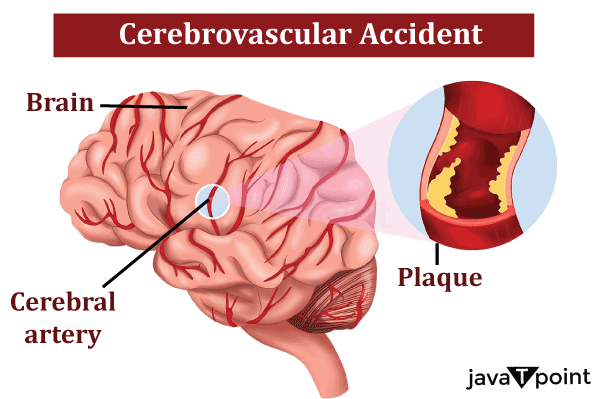Cerebrovascular Accident
The term "stroke" in medicine is known as "cerebrovascular accident" (CVA). A stroke happens when a blood vessel becomes blocked or ruptures, cutting off blood supply to a section of the brain. A number of stroke warning signs should be recognised and monitored. The prognosis will be better if you receive treatment as soon as possible because an untreated stroke might cause permanent brain damage.

Types of Cerebrovascular Accident
Cerebrovascular accidents, also referred to as strokes, come in two different forms. A blockage results in an ischemic stroke, whereas a blood vessel rupture results in a hemorrhagic stroke. By depriving a region of the brain of blood and oxygen, both types of strokes kill brain cells.
- Ischemic Stroke: A blood clot blocks a blood vessel, preventing blood and oxygen from reaching a particular area of the brain. When a blood clot travels from another region of the body and becomes lodged in a blood artery in the brain, an ischemic stroke develops. A thrombotic stroke, on the other hand, occurs when a clot forms within a blood vessel in the brain.
- Hemorrhagic Stroke: A hemorrhagic stroke occurs when a blood artery ruptures or bleeds, preventing blood from reaching a specific area of the brain. Any blood artery in the brain or the membrane that surrounds the brain might bleed.
Symptoms of a Cerebrovascular Accident
The sooner a stroke is recognised and treated, the higher your chances of recovery. As a result, understanding and recognising stroke symptoms is very important:
- Difficulties in Walking
- Dizziness
- Loss of balance and coordination
- Numbness or paralysis in the face, limb, or arm, usually on only one side of the body
Symptoms usually develop abruptly, even if they are not severe, and they may worsen with time. Remembering the term "FAST" assists people in recognising the most prevalent stroke symptoms:
- Face: Does one side of the face droop?
- Arm: If a person holds both arms out, does one drift downward?
- Speech: Is their speech abnormal or slurred?
- Time: It's time to call the doctor and get to the hospital if any of these symptoms are present.
Cerebrovascular Accident Diagnosis
A variety of tools can be used by healthcare experts to establish whether a person had a stroke. A doctor will do a comprehensive physical examination, testing your strength, reflexes, eyesight, speech, and senses. They will also listen for a specific sound in the blood vessels in your neck. A bruit is a sound that signals irregular blood flow. Finally, if a person had a stroke, their blood pressure may be elevated.
In order to ascertain the cause and location of the stroke, doctor may also request diagnostic testing. These tests may include one or more of the following:
- Blood testing: Blood tests may be ordered by a doctor to check for clotting time, blood sugar levels, or infection. All of these variables can influence the likelihood and severity of a stroke.
- Angiogram: An angiography, which consists of injecting a dye into your blood and taking an X-ray of your head, can help your doctor locate the blocked or haemorrhaged blood vessel.
- Carotid ultrasound: Sound waves are used in this examination to make images of the blood arteries in your neck.
- CT scan: A CT scan is usually performed soon after the onset of stroke symptoms. The exam might assist your provider in locating the problem location or other issues that may be related with stroke.
- MRI scan: An MRI, as opposed to a CT scan, can provide a more thorough image of the brain. It detects strokes with greater accuracy than a CT scan.
- Echocardiogram: Using sound waves, this imaging technology provides a picture of your heart. It can assist doctors in determining the source of the blood clots.
Treatment for a Cerebrovascular Accident
The type of stroke a person has determines their treatment. For example, the goal of ischemic stroke treatment is to restore blood flow. The goal of hemorrhagic stroke treatment is to stop the bleeding.
- Ischemic stroke treatment: In order to treat an ischemic stroke, the patient may be given a clot-dissolving medication or a blood thinner. Aspirin may also be administered to the patient to avoid a second stroke. For this form of stroke, emergency therapy may include injecting medication into the brain or clearing a blockage with a surgery.
- Hemorrhagic stroke treatment: If a person suffers from a hemorrhagic stroke, he or she may be given medication to help lower the pressure in their brain caused by the bleeding. If the bleeding is excessive, surgery to remove the excess blood may be required. They may need surgery to repair the broken blood vessel.
Prevention of a Cerebrovascular Accident
The main stroke risk factors include diabetes, atrial fibrillation, and hypertension (high blood pressure). Similarly, there are numerous actions you can take to assist avoid stroke. Stroke prevention measures are comparable to those used to help prevent heart disease. Person can take the following precautions:
- Keep your blood pressure normal and limit the intake of saturated fat and cholesterol.
- Quit smoking and drink alcohol intake.
- Keep diabetes under control.
- Keep a healthy weight.
- Engage in regular physical activity.
- Consume a diet rich in vegetables and fruits.
If the doctor believes that a person is at danger of having a stroke, he or she may prescribe anti-stroke medication. Drugs that thin the blood and inhibit clot formation are examples of potential stroke prevention treatments.
|

 For Videos Join Our Youtube Channel: Join Now
For Videos Join Our Youtube Channel: Join Now









